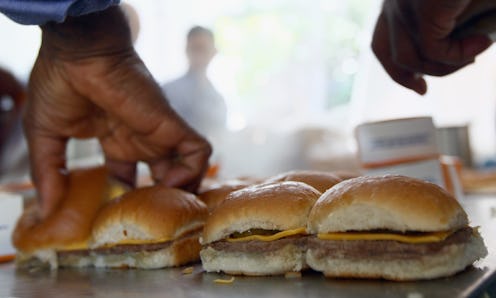News
Exactly Where The Norovirus Strikes
Today in disgusting news: Cruise ships have been the stomach bug scapegoat for too long, because it's actually restaurants that give you the norovirus gut bug. According to a new report from the Center for Disease Control and Prevention, the truly horrible virus — which is resistant to most types of hand sanitizers, disinfectant hand-washes and freezing temperatures — can survive for up to two weeks on table-tops, and is spread through the unwashed hands of food service workers, via the, er, fecal-oral route. Shudder. The CDC investigation looked at 1,008 foodborne norovirus outbreaks reported between 2009 and 2012.
Two-thirds of these could be traced back to restaurants, and especially to food service workers who didn't use gloves when handling food, or wash their hands well enough. Part of the problem? One in 5 workers will come into the restaurant, even when they're sick with vomiting and diarrhea, because of "fear of job loss."
Ingesting only 18 norovirus particles can lead to what any norovirus veteran will tell you is a nightmarish few days of nausea, vomiting, stomach pain and intense diarrhea — sometimes, all simultaneously. Between 19 and 21 million cases of norovirus occur each year; roughly 56,000 to 71,000 of those lead to hospitalization. It can even be fatal: 570 to 800 deaths are caused by the virus every year, reports the CDC. And the most likely place to pick up the virus — other than a nursing home — is a restaurant.
“It is vital that food service workers stay home if they are sick; otherwise, they risk contaminating food that many people will eat,” the CDC's Aron Hall said in a statement. “Businesses can consider using measures that would encourage sick workers to stay home, such as paid sick leave and a staffing plan that includes on-call workers,” said Hall.
The restaurant industry — particularly the fast food sector — is a hard place to stay. In general, roughly half of the workers at any fast food restaurant will be replaced each year, reports the Houston Chronicle. And this is in spite of the fact that fast-food workers typically earn 1,000 times less than their companies' CEOs (and how hard they've had to fight for a raise). Even restaurant workers outside the fast food industry have a tough time of it; the average restaurant employee gets only between $12,000 and $22,000 per year (depending on the type of restaurant and the type of job). So it's not hard to see why many will go into work, even when excruciatingly ill.
Basically, until the food industry learns to give its employees decent sick leave and decent pay, it's probably not a bad idea to scrutinize your order (beware those innocuous-looking salad-leaves and berries). Or go onto Yelp, the health department's newest best bud, when it comes to finding out about gastrointestinal issues caused by local eateries. The upside (ish)? At least you can comfortably go on a trip again — only a measly one percent of foodborne norovirus outbreaks can be blamed on cruise ships.
